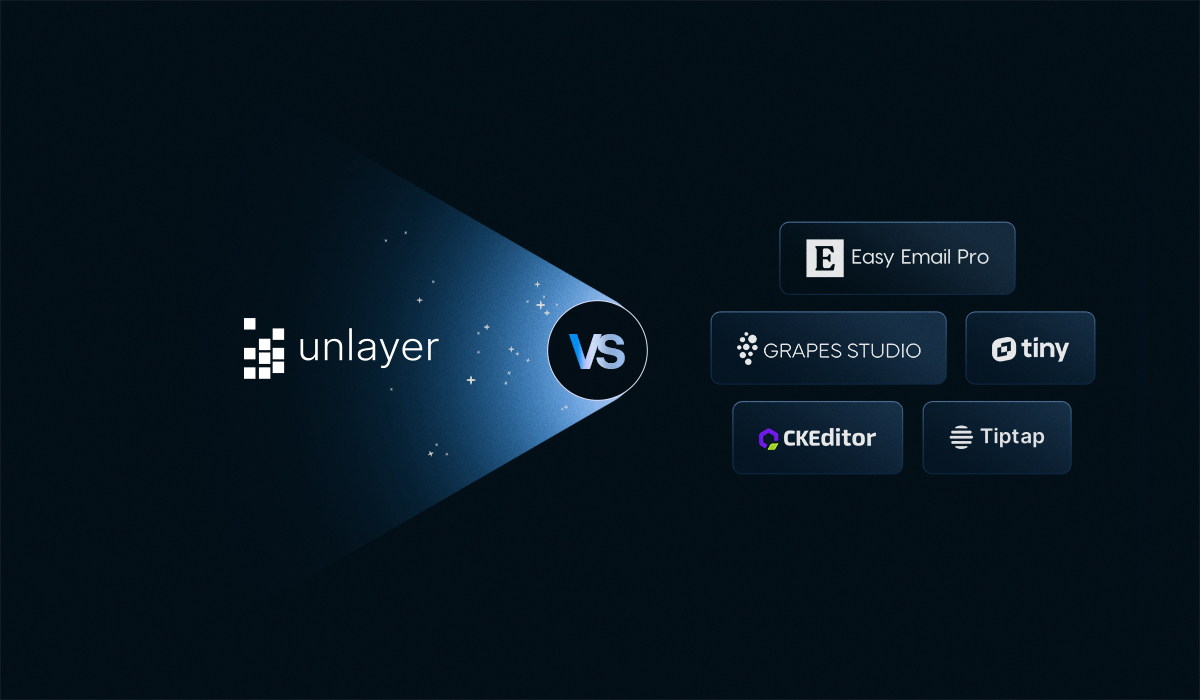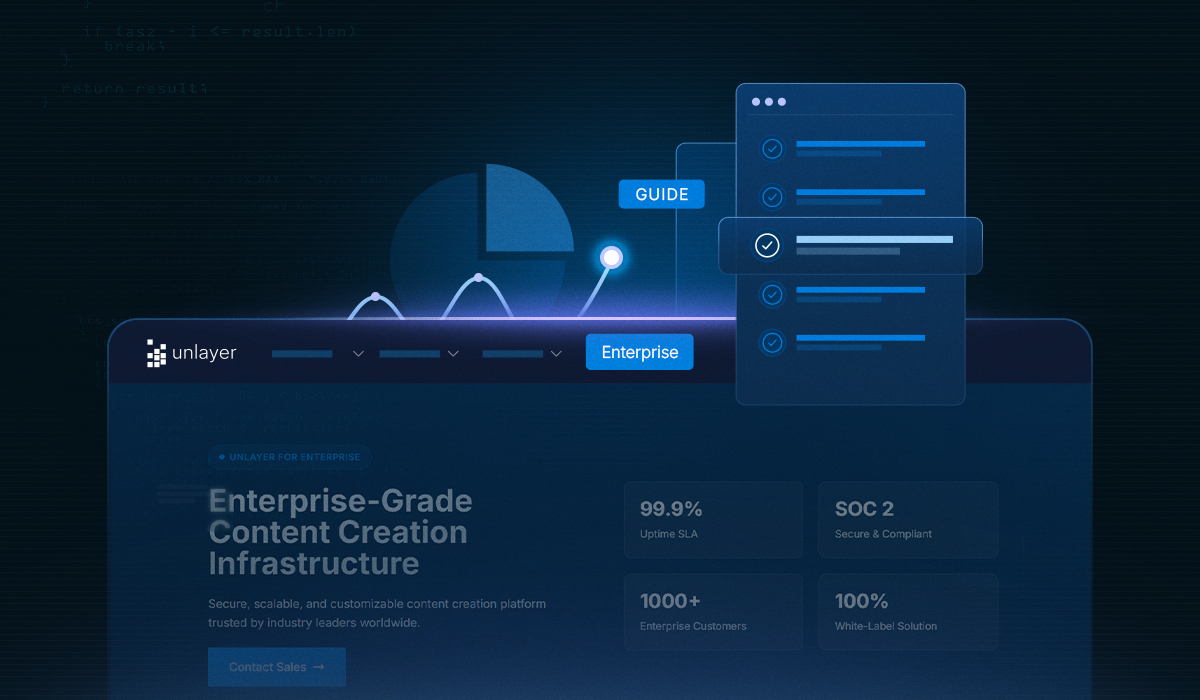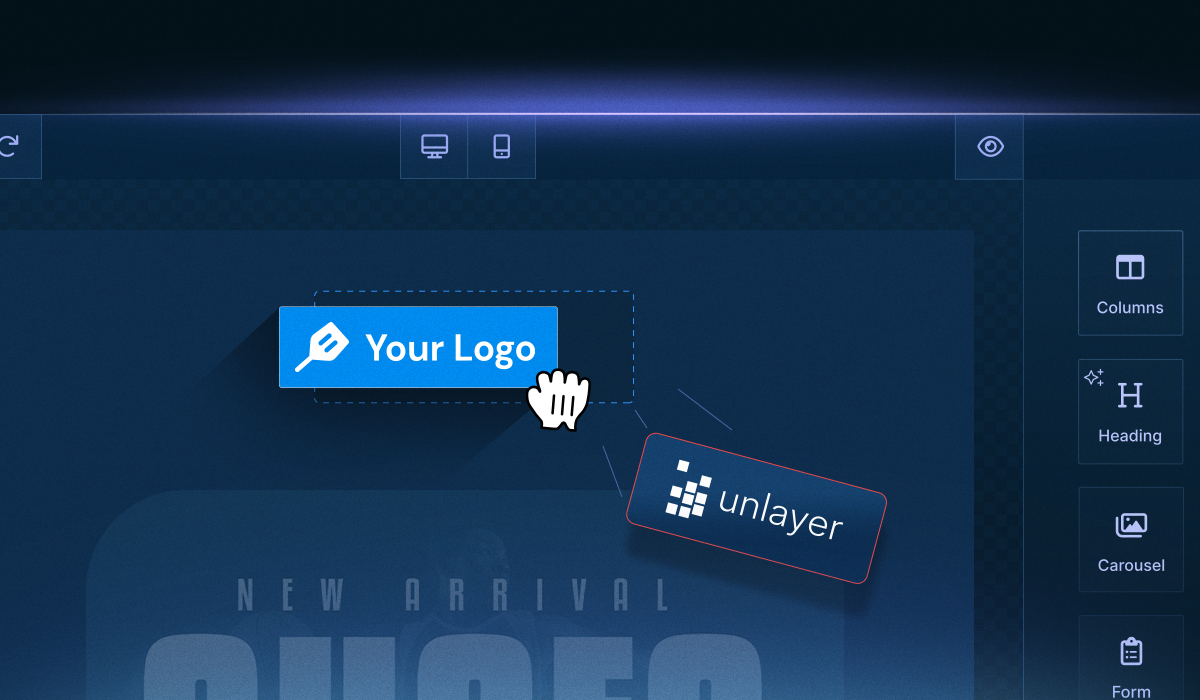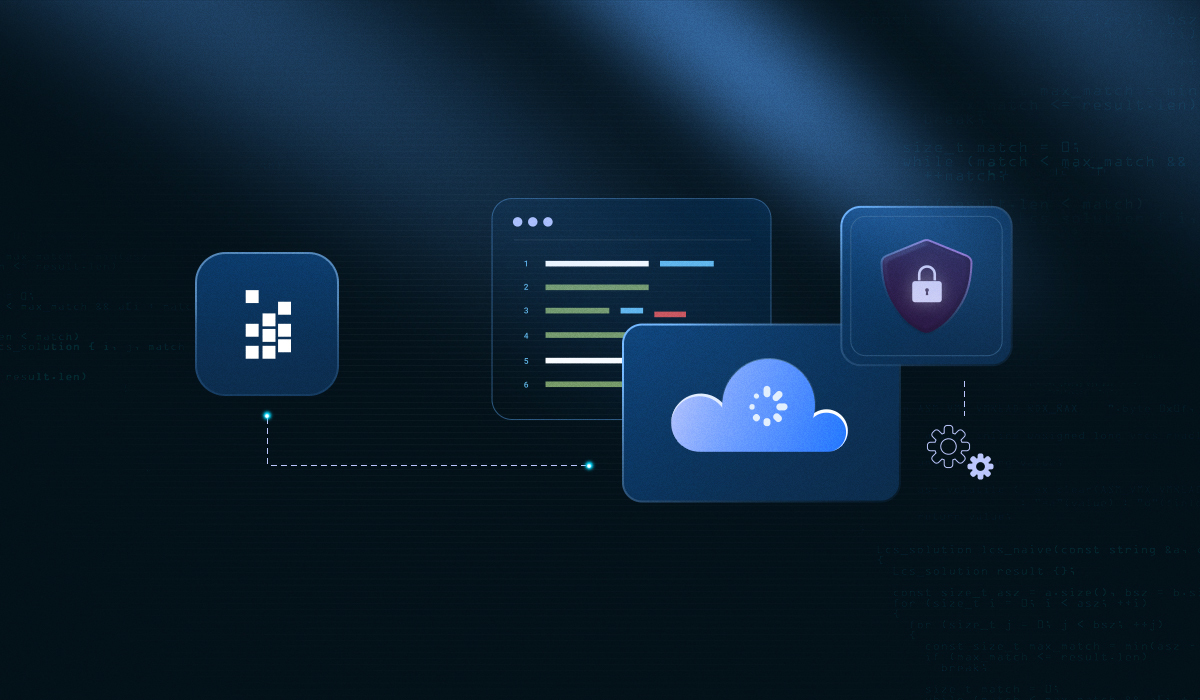When comparing Unlayer Enterprise vs. open-source editors, the real question isn’t just about features, it’s about the best fit.
Enterprise teams have unique requirements around security, scalability, and support that open-source solutions don’t always cover. On the other hand, open-source editors often win in terms of flexibility and cost.
This article dives deep into how Unlayer Enterprise stacks up against leading open-source email and page editors to help you decide which option best aligns with your product or business needs.
Here’s what we’ll cover:
The purpose of comparing Unlayer Enterprise vs open-source editors
Evaluation criteria: security, scalability, customization, and more
Key features and strengths of Unlayer Enterprise
A breakdown of popular open-source alternatives (GrapesJS, Easy Email, TinyMCE, CKEditor, TipTap, Postcards)
Side-by-side comparison tables for quick insights
Best-fit scenarios for both open-source and enterprise setups
Decision matrix to guide your final choice
By the end, you’ll have a clear understanding of which solution offers the right balance of control, compliance, and performance for enterprise-scale use cases.
Core Evaluation Metrics for Enterprise-Grade Editors
Before choosing between Unlayer Enterprise and open-source editors, it’s important to evaluate how each solution performs against core enterprise requirements.
Below are the key criteria that determine whether an editor can scale securely and efficiently within your organization.

1. Security & compliance
For enterprises handling sensitive customer or marketing data, compliance is non-negotiable. Look for solutions that meet standards like SOC 2 Type II and GDPR, offer secure data handling, and support user authentication methods such as SSO (Single Sign-On) and role-based access control (RBAC).
2. Deployment flexibility
Enterprises often require deployment options beyond the cloud, such as on-premise or private cloud setups, to maintain full control over data and integration environments.
Open-source editors may allow custom hosting, but enterprise-grade tools streamline configuration, updates, and security patches.
3. Customization & embedding
Modern teams expect editors that integrate seamlessly into existing workflows and products.
API-first and SDK-based architectures, like those offered by Unlayer Enterprise, enable deep embedding and white-labeling capabilities, which are ideal for SaaS platforms and internal tools needing branded editing experiences.
4. Scalability & performance
As user volume and data grow, the editor must maintain fast load times and reliable performance.
Enterprise solutions are optimized for high concurrency, auto-scaling, and uptime SLAs, while open-source tools often rely on manual performance tuning.
5. Collaboration & governance
Enterprises benefit from built-in collaboration, version control, and audit logs that ensure accountability.
These features simplify approval workflows and track every change for compliance, something open-source editors may require third-party integrations to achieve.
6. Support & maintenance
Open-source projects rely heavily on community contributions for bug fixes and updates.
In contrast, enterprise solutions provide dedicated support teams, SLAs, and a customer success manager, ensuring long-term stability and rapid issue resolution.
7. Total Cost of Ownership (TCO)
While open-source editors may appear cost-effective upfront, ongoing development, security, and maintenance costs can add up quickly.
Enterprise solutions typically involve paid subscriptions but reduce internal overhead, accelerate deployment, and deliver measurable ROI through reliability and support.
Related: 7 Hidden Costs of Building an In-House Email & Page Builder
Overview of Unlayer Enterprise

Unlayer Enterprise is designed as a robust, embeddable content creation platform tailored for enterprise-scale applications. It blends security, customization, governance, and support.
Below is a deeper look at its features, strengths, and trade-offs.
⚙️ Key features

1. SOC 2 Type II and GDPR compliance
Unlayer is SOC 2 Type II certified and GDPR compliant as part of its enterprise offering.
Additional security measures include encryption (at rest and in transit), vulnerability scanning, DDoS protection, and compliance monitoring.
It also provides audit logging, access controls, backup/recovery, and network security to support regulatory and governance needs.
2. On-premise and private cloud deployment options
To meet stricter data residency or infrastructure constraints, Unlayer Enterprise supports on-premise deployments or deployment within private or isolated environments.
This gives organizations full control over their infrastructure, network boundaries, and integration with internal systems.
3. API-first and SDK-based embedding capabilities
Unlayer is built to embed smoothly into SaaS platforms or internal tools via robust APIs, SDKs, and framework-specific plugins like React, Vue, and Angular.
The API allows programmatic control over loading, saving, exporting designs, and retrieving data from the backend systems.
Developers can define custom tools, tweak UI behavior, customize appearance (themes, branding), editor behavior, content settings, and inject custom logic via Custom JS / CSS.
4. Role-based access control, SSO, and collaboration tools
The enterprise edition supports fine-grained role-based access control (RBAC) with custom roles and permissions.
It includes Single Sign-On (SSO) support (SAML, OAuth, custom authentication) to integrate with corporate identity systems.
Collaboration features like shared editing, template permissions, review workflows, and team structures are part of the enterprise offering.
5. Audit logs, analytics, and version history for governance
Unlayer provides detailed audit trails and logs of edits, who made what change, and when, supporting compliance and traceability.
Usage analytics and reporting dashboards give visibility into editor use, performance, and patterns across teams.
Version history and rollback capabilities help in governance, enabling administrators to revert changes or track document evolution.
6. Dedicated success manager and enterprise support
With the enterprise tier, Unlayer promises 24/7 priority support, dedicated customer success managers (CSMs), and technical account management.
Implementation assistance, training, custom integration help, and migration support are part of its professional services offerings.
💪 Strengths
Drawing from Unlayer’s own claims and user feedback, here are some standout advantages:
Enterprise-grade security and reliability: The combination of SOC 2, encryption, auditability, and SLAs provides a trustworthy foundation for regulated and large organizations.
Lower internal maintenance burden: Because much of the infrastructure, updates, and security are handled by Unlayer, internal teams don’t need to reinvent the wheel.
Advanced white-labeling and customization options: You can tailor the editor’s look, feel, and behavior to match your product’s brand without exposing “Unlayer” branding.
Related: How to White-Label Your Embeddable Editor for SaaS Platforms
Scales across large teams and applications: The system is designed to handle high concurrency, distributed teams, and embedding across multiple product surfaces.
⚠️ Limitations
Even powerful systems have trade-offs. Some known limitations or caveats for Unlayer Enterprise include:
Paid subscriptions: The enterprise tier is a premium offering with custom pricing, and initial setup, training, or migration may carry substantial costs.
💡 Note: Pricing can vary depending on the features, deployment options, and level of support your team requires. You can explore detailed plan comparisons on the Unlayer Enterprise vs Self-Serve Plans.
4 Open-Source Editors in Comparison
Four leading open-source editors to benchmark:
Editor | Core Features | Pros | Cons |
GrapesJS | Drag-and-drop builder, plugin ecosystem, asset & style manager | Highly customizable, free, large community | Requires manual setup, limited enterprise support |
Easy-Email Editor | React + MJML based, responsive templates, custom blocks | Developer-friendly, modern, flexible | UI less polished, lacks analytics & governance |
TinyMCE / CKEditor / TipTap | Rich-text editors with collaborative features | Mature ecosystems, reliable | Not full visual builders, less suited for email/page design |
Postcards | Visual drag-and-drop email builder, real-time editing | Easy for marketers, fast output | Not fully open source, lacks enterprise compliance & scalability |
Further details & GitHub links of the open-source editors
1. GrapesJS
GrapesJS is one of the more mature visual HTML template editors. It offers a plugin infrastructure, style & layer managers, and the ability to extend core behavior via its API.
GitHub: GrapesJS / grapesjs
2. Easy-Email Editor
Built atop React and MJML, Easy-Email offers a modern editor with responsive email template generation, drag-and-drop design, and block-based structure.
GitHub: Easy-Email-Pro / easy-email-editor-pro
(Also note: the base open-source version is available under zalify/easy-email-editor on GitHub.)
3. TinyMCE / CKEditor / TipTap
These are more classic rich-text or WYSIWYG editors with support for inline editing, formatting toolbars, and collaboration extensions. They are well established but are not built for full visual layout building in the way drag-and-drop page or email design tools are.
TinyMCE: known for a strong plugin ecosystem
CKEditor: solid enterprise usage, collaborative editing support
TipTap: modern, headless editor built on top of ProseMirror
4. Postcards
Postcards is more of a visual email builder intended for marketers. It offers quick drag-and-drop design, real-time editing, and nice templates.
The trade-offs are in lower compliance, less open-source openness, and less flexibility for deep embedding or governance functionality.
Side-by-Side Comparison: Unlayer Enterprise vs. Open-Source Editors
Category | Open-Source Editors | Unlater Enterprise |
Security & Compliance | Minimal compliance features; no audit logs or SSO | SOC 2 Type II, GDPR, audit logs, SSO, RBAC |
Deployment | Fully self-hosted; high setup effort | On-premise / private cloud with managed support |
Customization | Plugin-based; requires developer effort | SDKs & APIs with white-labeling and extensive customization options |
Scalability | May slow under heavy load; limited team support | Built for large-scale operations and multi-team use |
Support & Maintenance | Community support only | Dedicated CSM, training, and SLAs |
Cost | No licensing cost; higher developer overhead | Licensing cost; lower long-term maintenance |
Time-to-Value | Requires setup, testing, and custom workflows | Faster deployment and adoption for enterprise teams |
Unlayer Enterprise vs. Open-Source Editors: Best-Fit Scenarios
Choosing between Unlayer Enterprise and open-source editors ultimately depends on your organization’s size, technical capabilities, and long-term priorities.
Here’s how to identify which path fits your setup best.
💻 When open-source editors make sense
Open-source editors shine in environments where flexibility and developer control matter most. They allow you to build highly tailored experiences without licensing constraints, but success often depends on internal expertise and resource bandwidth.
They’re a great fit for:
Small to mid-sized teams with strong in-house engineering talent.
Organizations prioritizing cost efficiency over compliance or managed infrastructure
Projects requiring experimentation, such as startups iterating fast or building proofs of concept.
In these cases, open-source solutions like GrapesJS, Easy-Email, or TipTap let you move fast, modify freely, and maintain full code-level ownership, provided you can handle ongoing maintenance and support in-house.
💡 Note: While open-source tools are ideal for cost-effective teams, Unlayer also offers self-serve plans that cater to small and mid-sized businesses. These plans are cost-effective and designed to help teams scale without the overhead of managing open-source infrastructure.
🏢 When Unlayer enterprise excels
Unlayer Enterprise is purpose-built for organizations that can’t compromise on compliance, uptime, security, and brand consistency. It offers enterprise-grade reliability, SDK and framework-specific plugins for integrations, and governance tools that minimize internal complexity while scaling with your business.
It’s best suited for:
Large enterprises or regulated industries needing security, auditability, and governance.
SaaS platforms embedding editors within existing ecosystems or customer-facing products.
Teams that rely on SLAs, 24/7 uptime guarantees, and priority support for business continuity.
Organizations emphasizing brand control and consistency across distributed teams.
With Unlayer Enterprise, teams get the peace of mind that comes from dedicated support, compliance readiness, and infrastructure built to handle thousands of concurrent users, without the maintenance overhead.
✨ Ready to see how Unlayer Enterprise can fit your tech stack?
Book a demo or sign up to explore what enterprise-grade embedding and customization can look like for your team.
🧩 Decision matrix
To help summarize which option aligns best with different business goals, here’s a quick reference table:
Business Need | Recommended Option |
Rapid deployment & scalability | Unlayer Enterprise |
Cost-sensitive, developer-led projects | Open-Source Editors |
Security & compliance-driven environments | Unlayer Enterprise |
High customization & in-house control | Unlayer Enterprise |
Multi-team governance & collaboration | Unlayer Enterprise |
Final Takeaway
The choice between Unlayer Enterprise vs open-source editors comes down to how your organization balances control, compliance, and scalability.
Open-source tools offer unmatched freedom for developer-led teams, ideal for those who want full ownership of their codebase and can manage infrastructure, updates, and support internally.
They’re a smart choice for smaller teams focused on experimentation or lean product builds.
Unlayer Enterprise, on the other hand, delivers the structure and reliability that large-scale operations demand. With built-in compliance, dedicated support, and scalable deployment options, it allows enterprises to focus on growth instead of maintenance.
If your organization values security, governance, and seamless scalability, Unlayer Enterprise stands out as the long-term solution that grows with you.
FAQs: Unlayer Enterprise vs Open-Source Editors
1. Is Unlayer Enterprise open source?
No. Unlayer Enterprise is a commercial solution built for large-scale teams that require compliance, uptime SLAs, and enterprise support.
However, it’s API-first and SDK-based, offering the same flexibility developers expect from open-source tools, without the overhead of managing code or infrastructure.
2. Can I self-host Unlayer Enterprise?
Yes. Unlayer Enterprise supports on-premise and private cloud deployments, giving your organization full control over your data and environment, an advantage for regulated industries or internal security policies.
3. Do open-source editors provide enterprise-level support?
Typically, no. Open-source editors rely on community-driven support, which can vary in speed and reliability. While some have active communities or paid add-ons, they generally don’t offer dedicated success managers, SLAs, or compliance audits like Unlayer does.
4. What if my team outgrows an open-source editor?
You can migrate to Unlayer’s Enterprise or Self-Serve plans when your needs evolve, especially if you require advanced collaboration, customization, security, and compliance. The SDK-based embedding model makes migration smoother for developers who are already comfortable with frontend integrations.
5. Is Unlayer suitable for small or mid-sized teams?
Yes. While the Enterprise plan targets large organizations, Unlayer also offers self-serve plans that are budget-friendly and ideal for smaller teams looking to build professional emails or landing pages without heavy infrastructure investment.
6. How does Unlayer Enterprise handle data privacy and compliance?
Unlayer Enterprise adheres to SOC 2 Type II and GDPR compliance standards, ensuring robust data protection, access control, and auditability.
It also supports SSO, role-based permissions, and audit logs, helping enterprises meet internal governance and external regulatory requirements with confidence.




